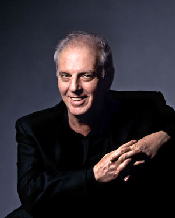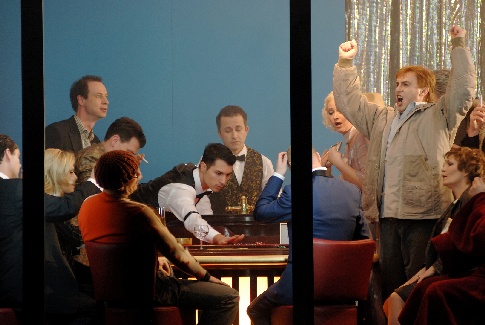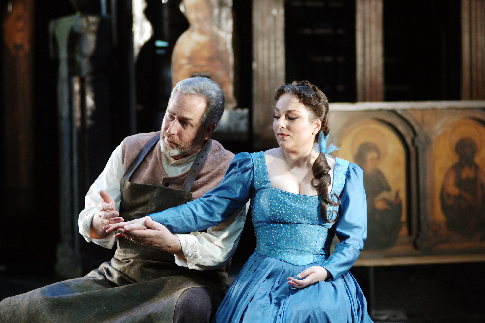07 Apr 2008
Barenboim and Berlin — beauty and brilliance
BERLIN — Which car-rental agency was it that was once No. 2 and “trying harder?”

BERLIN — Which car-rental agency was it that was once No. 2 and “trying harder?”
No one remembers, for today — if lines at airport counters are an indication — the two are neck and neck with both doing well. Their competition comes to mind, however, here in Berlin, where the Philharmonic, looking back on golden ages under Wilhelm Furtwängler and Herbert von Karajan, has long been the No. 1 orchestra not only here, but — in the eyes of many — in the whole world. In the long-divided city the Staatskapelle, on the other hand, attracted little attention in its primary role as the competent but colorless pit band in the historic Staatsoper on Unter den Linden in the East. Then — in 1989 — the Wall came down, and — in 1992 — Daniel Barenboim was made maestro of the opera and its orchestra.
 Daniel Barenboim
Daniel Barenboim
A week in the city over Easter underscored his success in bringing to both a brilliance that declares them no longer No. 2 to anyone. Easter is, of course, the time for Barenboim and his forces to shine, for the Philharmonic and its charismatic conductor Simon Rattle are off in Salzburg for the spring festival that Karajan founded there. Barenboim performances are the heart of the local “Festtage,” a mini-festival instituted even before the Wall was built to attract audiences to the East.
On March 16 Barenboim kicked off the series at the Staatsoper with the first Berlin staging of Prokofiev’s “The Gambler,” a torrid tale of love and the loss of fortunes based on Dostoyevsky’s 1866 novella that reflected the author’s own addiction to gambling. In an eye-catching updating by Dmitri Tcherniakov, responsible also for sets and costumes, gamblers were on stage in fictional Roulettenburg even before the music began. Prokofiev went to work on “Gambler” in 1915 when he was 24. A first version was slated for production in St. Petersburg, but cancelled when street fighting heralded the revolution. Plans for a Russian staging were later scrapped because the composer was living abroad. The opera — revised in 1927-‘28, was premiered in Brussels in 1929 and has had only a handful of stagings since then. (It played at the Chicago Lyric Opera in 1991.) This made the production at the Staatsoper, where Barenboim is cherished above all for his work with Mozart and Wagner, an event of special interest, and — with best seats selling at 260 Euros (around $400) — the historic house was packed.
 Scene from The Gambler
Scene from The Gambler
Conductor and orchestra had fully mastered Prokofiev’s chrome-plated score, which with its sharp edges and abrupt corners recalls that “Gambler” is the contemporary of Berg’s “Wozzeck.” The work’s study of a society sick to the depths of its soul is of obvious contemporary relevance. Largely through-composed, “Gambler” gives primacy to the text — sung here in Russian with titles in German, and for it Barenboim assembled a cast of two dozen that was without a weak link. Christine Opolais was stellar and sympathetic as Polina, a young newly rich woman unable to believe that a man could love her without selfish goals, and as that young man Misha Didyk was a dramatically overwhelming Alexej. Outstanding were two character roles: Stefania Toczyska as the matriarchal Babulenka who gambles away jewels and furs to stand figuratively naked before false gods, and bass Vladimir Ognovenko as the equally depraved General. “Gambler” tells a dark and threatening story. Barenboim and his ensemble told it with conviction.
 Scene from Die Meistersinger: James Morris (Hans Sachs) and Dorothea Röschmann (Eva)
Scene from Die Meistersinger: James Morris (Hans Sachs) and Dorothea Röschmann (Eva)
Barenboim was back on the podium on Palm Sunday to conduct Harry Kupfer’s stunningly colorful production of that most German of all operas, “Die Meistersinger,” and it was on this familiar Wagnerian turf that the he and the Staatsoper were of truly unsurpassable excellence. In his sensitive approach to the Overture Barenboim made voices audible that one had never heard before, and the pathos-ridden Prelude to Act Three, often tossed aside unthinkingly en route to the pageantry of the final scene, was gripping in its bitter sweetness.
In his house debut James Morris, the reigning Wotan of his generation, was touchingly convincing as Hans Sachs, Wagner’s shoemaker torn between his own love for Eva and his support for young Walter in his efforts to break the ossified rules of the master minstrels. Morris played an understated Sachs and was in even smoother and richer voice here than he was for his debut in the role at the San Francisco Opera in 2001 and in the DVD that originated at the Met the following season. Dorothea Röschmann, a Mozartian now moving into lighter Wagner roles, sang Eva with ease and clarity, while Burkhard Fritz was a Walter of often bashful youth. Among the masters Rene’ Pape stood out as an aristocratic Pogner, and Roman Trekel was a handsome — if pedantic — Beckmesser, who avoided clichés of self-parody. And while David and Magdalene are roles often assigned to singers on the eve of retirement, it was refreshing to hear them sung — and sung well — by youthful Florian Hoffmann and Katharina Kammerloher. Yet it was Barenboim who made these two evenings a triumph of perfection. Everything spoke of immense care and concern for the task at hand. And it was a nice touch that Barenboim brought the entire orchestra on stage for a curtain call at the end of “Meistersinger.”
To fully appreciate the excellence of the Staatskapelle, however, one must hear them out of the pit in concert. On March 20 Barenboim took the orchestra to the Philharmonic Hall, Hans Scharoun’s 1963 masterpiece that is beyond doubt the world’s most successful — and beautiful — concert venue. There one witnessed the interaction of Staatskapelle musicians and experienced how closely “in sync” they are with Barenboim. Highlight of the program was Brahms’ D Minor Concerto, played by Lang Lang, today’s sensation among young pianists.
One doubted a few years ago whether the Chinese-born pianist would be able to handle the success that he was, but today it is happily clear that at 25 he has found himself and is headed towards even greater things in the future. Here, again, however, Barenboim deserved much credit for the experience that this was. Long a master among pianists, he know this concerto inside and out, and it was fascinating to watch — and hear — him guide his orchestra through it. This was conducting as it should always be: instructive, shaping and forming — recreating, in short, the piece at hand. It was evident that he and Lang Lang had worked together carefully to make this a memorable performance.
Barenboim, in sum, is one of today’s great artists, and his influence and impact are felt far beyond Berlin. He is the man who broke the Israel taboo on Wagner by conducting the Prelude and “Liebestod” from “Tristan” as an encore there in 2001 — to near-violent reaction from many in the state. He worked with Palestinian scholar Edward Said to found the West-Eastern Divan, an ensemble of young musicians from countries throughout the Middle East that is now of legendary fame. A citizen of Israel, he has now acquired Palestinian citizenship as well.
*******
A note on the Berlin Staatsoper. The building, built originally in 1740 by Friedrich the Great and destroyed and rebuilt many times since then, is in a horrid state of disrepair. Walls are dirty and cracked; carpets are threadbare and floor creak. The building is scheduled to close in 2010 for three years of reconstruction to cost some $260 million.
Wes Blomster